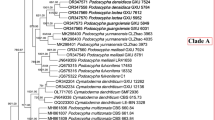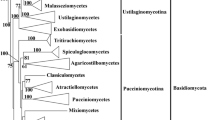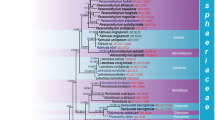Abstract
For the purpose of determining phylogenetic relationships within the Dacrymycetales, we conducted molecular phylogenetic analyses based on sequences of the 28S rRNA gene D1/D2 region using neighbor-joining and maximum-likelihood methods. Although the phylogenetic relationships at higher taxonomic levels were not resolved, we obtained some new information about inter- and intrageneric relationships in this order. Dacrymyces punctiformis formed a clade with Cerinomyces spp., and D. stillatus, D. minor, D. chrysospermus, and D. subalpinus constituted a clade with Guepiniopsis buccina. These clades and other Dacrymyces species were scattered over the Dacrymycetales lineage. The results suggest that Dacrymyces is polyphyletic. Our study suggests that basidiocarp morphology has limited taxonomic value at the generic or familial level and that there is a need for a taxonomic reassessment of this order, including a redescription of Dacrymyces.
Similar content being viewed by others
References
D Begerow R Bauer F Oberwinkler (1997) ArticleTitlePhylogenetic studies on nuclear large subunit ribosomal DNA sequences of smut fungi and related taxa Can J Bot 75 2045–2056 Occurrence Handle1:CAS:528:DyaK1cXitFeit7k%3D Occurrence Handle10.1139/b97-916
J Boidin G Gilles (1986) ArticleTitleBasidiomycetes Aphyllophorales de lile de la reunion VI. Le genre Cerinomyces Martin Bull Soc Mycol Fr 102 315–319
J Felsenstein (1985) ArticleTitleConfidence limits on phylogenies: an approach using the bootstrap Evolution 39 783–791 Occurrence Handle10.2307/2408678
M Hasegawa H Kishino T Yano (1985) ArticleTitleDating of the human-ape: splitting by a molecular clock of mitochondrial DNA J Mol Evol 22 160–174 Occurrence Handle3934395 Occurrence Handle10.1007/BF02101694 Occurrence Handle1:CAS:528:DyaL2MXmtFSns7g%3D
DS Hibbett L-B Gilbert MJ Donoghue (2000) ArticleTitleEvolutionary instability of ectomycorrhizal symbioses in basidiomycetes Nature 407 506–508 Occurrence Handle11029000 Occurrence Handle10.1038/35035065 Occurrence Handle1:STN:280:DC%2BD3cvnslKgsg%3D%3D
W Jülich (1981) Higher taxa of basidiomycetes Cramer Vaduz
R Kirschner ZL Yang (2005) ArticleTitleDacryoschyphus chrysochilus, a new staurosporous anamorph with cupulate conidiomata from China and with affinities to the Dacrymycetales (Basidiomycota) Antonie van Leeuwenhoek 87 329–337 Occurrence Handle15928985 Occurrence Handle10.1007/s10482-004-6784-9 Occurrence Handle1:CAS:528:DC%2BD2MXks1Oisbw%3D
Y Kobayasi (1939) ArticleTitleOn the Dacrymyces-group Sci Rep Tokyo Bunrika Daigaku Sect B 4 105–128
K-H Larsson E Larsson U Kõljalg (2004) ArticleTitleHigh phylogenetic diversity among corticoid homobasidiomycetes Mycol Res 108 983–1002 Occurrence Handle15506012 Occurrence Handle10.1017/S0953756204000851 Occurrence Handle1:CAS:528:DC%2BD2cXns1Onurg%3D
B Lowy (1968) ArticleTitleTaxonomic problems in the Heterobasidiomycetes Taxon 17 118–127 Occurrence Handle10.2307/1216500
Y Matsuda N Hijii (1999) ArticleTitleCharacterization and identification of Strobilomyces confusus ectomycorrhizas on momi fir by RFLP analysis of the PCR-amplified ITS region of the rDNA J For Res 4 145–150 Occurrence Handle10.1007/BF02762239
RFR McNabb (1965a) ArticleTitleTaxonomic studies in the Dacrymycetaceae II. Calocera (Fries) Fries N Z J Bot 3 31–58
RFR McNabb (1965b) ArticleTitleTaxonomic studies in the Dacrymycetaceae III. Dacryopinax Martin N Z J Bot 3 59–72
RFR McNabb (1965c) ArticleTitleTaxonomic studies in the Dacrymycetaceae IV. Guepiniopsis Patouillard N Z J Bot 3 159–169
RFR McNabb (1965d) ArticleTitleTaxonomic studies in the Dacrymycetaceae VI. Femsjonia Fries N Z J Bot 3 223–228
RFR McNabb (1973) ArticleTitleTaxonomic studies in the Dacrymycetaceae VIII. Dacrymyces Nees ex Fries N Z J Bot 11 461–524
RFR McNabb PHB Talbot (1973) Holobasidiomycetidae: Exobasidiales, Brachybasidiales, Dacrymycetales GC Ainsworth FK Sparrow AS Sussman (Eds) The fungi, vol IV B Academic Press New York 317–325
F Oberwinkler (1993) ArticleTitleGenera in a monophyletic group: the Dacrymycetales Mycol Helv 6 35–72
K O'Donnell (1993) Fusarium and its near relatives DR Reynolds JW Taylor (Eds) The fungal holomorph: mitotic, meiotic and pleomorphic speciation in fungal systematics CAB International Wallingford 225–233
LS Olive (1944) ArticleTitleNew or rare heterobasidiomycetes from North Carolina-I J. Elisha Mitchell Sci Soc 60 17–26
SW Peterson (2000) Phylogenetic analysis of Penicillium species based on ITS and lsu-rDNA nucleotide sequences RA Samson JI Pitt (Eds) Integration of modern taxonomic methods for Penicillium and Aspergillus classification Harwood Amsterdam 163–178
DA Reid (1974) ArticleTitleA monograph of the British Dacrymycetales Trans Br Mycol Soc 62 433–494 Occurrence Handle10.1016/S0007-1536(74)80060-4
N Saitou M Nei (1987) ArticleTitleThe neighbor-joining method: a new method for reconstructing phylogenetic trees Mol Biol Evol 4 406–425 Occurrence Handle3447015 Occurrence Handle1:STN:280:DyaL1c7ovFSjsA%3D%3D
DL Swofford (2000) PAUP Phylogenetic analysis using parsimony (and other methods), version 4 Sinauer Associates Sunderland
JD Thompson DG Higgins TJ Gibson (1994) ArticleTitleCLUSTAL W: improving the sensitivity of progressive multiple sequence alignment through sequence weighting, position-specific gap penalties and weight matrix choice Nucleic Acids Res 22 4673–4680 Occurrence Handle7984417 Occurrence Handle10.1093/nar/22.22.4673 Occurrence Handle1:CAS:528:DyaK2MXitlSgu74%3D
M Weiß F Oberwinkler (2001) ArticleTitlePhylogenetic relationships in Auriculariales and related groups: hypotheses derived from nuclear ribosomal DNA sequences Mycol Res 105 403–415 Occurrence Handle10.1017/S095375620100363X
M Weiß M-A Selosse K-H Rexer A Urban F Oberwinkler (2004) ArticleTitleSebacinales: a hitherto overlooked cosm of heterobasidiomycetes with a broad mycorrhizal potential Mycol Res 108 1003–1010 Occurrence Handle15506013 Occurrence Handle10.1017/S0953756204000772
K Wells (1994) ArticleTitleJelly fungi, then and now! Mycologia 86 18–48 Occurrence Handle10.2307/3760717
K Wells RJ Bandoni (2001) Heterobasidiomycetes DJ McLaughlin EG McLaughlin PA Lemke (Eds) The mycota, vol VII B Springer New York 85–120
Author information
Authors and Affiliations
Corresponding author
About this article
Cite this article
Shirouzu, T., Hirose, D. & Tokumasu, S. Sequence analyses of the 28S rRNA gene D1/D2 region suggest Dacrymyces (Heterobasidiomycetes, Dacrymycetales) is polyphyletic. Mycoscience 48, 388–394 (2007). https://doi.org/10.1007/s10267-007-0378-0
Received:
Accepted:
Published:
Issue Date:
DOI: https://doi.org/10.1007/s10267-007-0378-0




